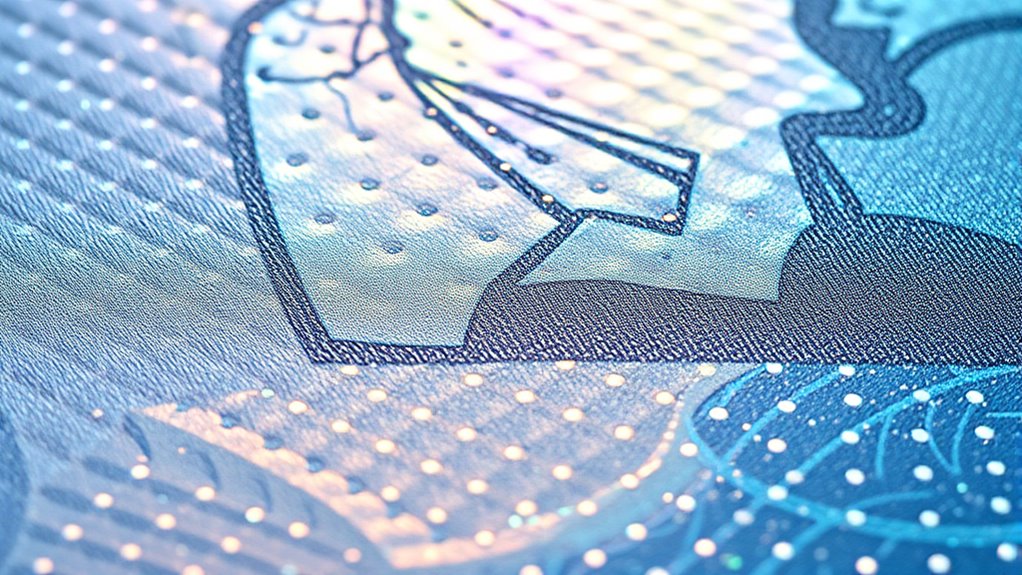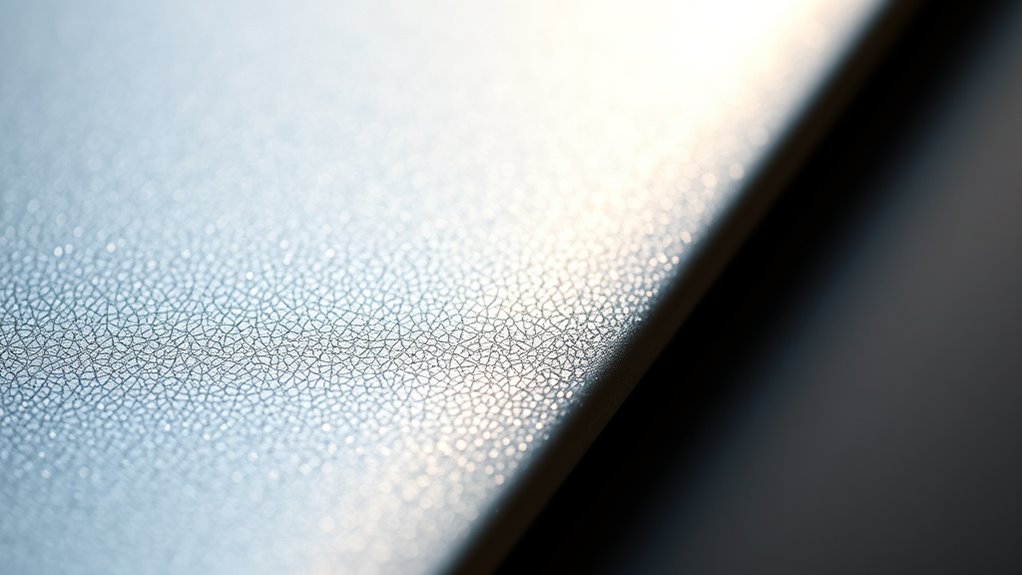Nanomaterial coatings enhance anti-counterfeiting and security by offering unique physical and chemical features that are hard to replicate. They provide durable, environmentally stable surfaces, with options like color-changing effects, luminescence, and optical interference. These thin coatings can embed nanoscale markers or quantum dots, making counterfeit attempts extremely difficult. Incorporating nanomaterials into security systems improves protection for banknotes, passports, and luxury goods. Explore further to discover how these innovative coatings are transforming security practices and what future advancements hold.
Key Takeaways
- Nanomaterial coatings enhance security through unique optical, magnetic, and chemical properties that are difficult to clone.
- They enable advanced features like luminescence, color-shifting effects, and holograms for covert anti-counterfeiting.
- These coatings improve durability, environmental stability, and resistance against wear, chemicals, and heat.
- Integration with digital systems and AI improves authentication accuracy and security management.
- Nanomaterial-based security features are scalable, cost-effective, and suitable for documents, currency, and luxury goods.
The Science Behind Nanomaterial Coatings in Security Applications

Nanomaterial coatings enhance security features because their unique physical and chemical properties enable the creation of advanced anti-counterfeiting measures. These coatings often form biocompatible surfaces, making them suitable for sensitive applications like currency and identification documents. Their environmental stability guarantees they remain effective under various conditions, resisting degradation from moisture, heat, or chemicals. This durability helps prevent counterfeiting, as fake labels or surfaces can’t easily mimic these robust properties. The nanoscale size allows for precise manipulation of surface characteristics, such as optical or magnetic features, which can be embedded into security elements. Additionally, understanding the AI vulnerabilities associated with digital security is crucial in developing comprehensive anti-counterfeiting strategies. As a result, you gain a reliable layer of protection that’s difficult for counterfeiters to replicate, leveraging the fundamental science of nanomaterials to enhance security without compromising safety or performance.
Key Features and Benefits of Nanocoatings for Anti‑Counterfeiting

The unique physical and chemical properties of nanomaterial coatings translate into a range of powerful features that make them ideal for anti-counterfeiting applications. These coatings offer durability enhancement, ensuring they withstand wear and tear over time. Their environmental stability allows them to perform reliably under various conditions, from UV exposure to moisture. Additionally, nanocoatings enable innovative security features like color-changing effects, luminescence, and optical interference, making counterfeiting difficult. They also provide thin, lightweight layers that don’t compromise product design. Overall, nanomaterials enhance security without sacrificing performance or longevity. You benefit from coatings that maintain their integrity and visual properties, making counterfeiting considerably more challenging and protecting your brand’s authenticity.
Techniques for Embedding Unique Identifiers With Nanomaterials

Embedding unique identifiers into nanomaterial coatings involves integrating specialized markers or codes directly at the nanoscale, making them extremely difficult to replicate or remove. Techniques include embedding quantum dots, which emit distinctive light signatures under specific conditions, allowing for precise identification. You can also utilize DNA barcoding, attaching synthetic DNA sequences to nanomaterials that encode unique information. These methods provide high security because quantum dots are nearly impossible to clone without specialized equipment, and DNA barcodes are highly customizable and tamper-proof. By embedding these nanoscale identifiers, you create robust, covert security features that are resistant to counterfeiting. This approach ensures that each item can be accurately authenticated, leveraging the unique, complex properties of nanomaterials for enhanced security.
Real-World Examples of Nanomaterial Use in Secure Documents and Currency

You’ve likely seen holographic security features on banknotes or ID cards that change appearance with movement. Nanoparticle ink applications are also increasingly used to create complex, hard-to-reproduce patterns. These nanomaterial-based techniques enhance security and help prevent counterfeiting in real-world documents and currency. Additionally, diversification strategies in nanomaterial coatings contribute to more robust anti-counterfeiting measures by integrating multiple security features into a single layer.
Holographic Security Features
Holographic security features harness nanomaterials to create dynamic, hard-to-counterfeit images that are integrated into banknotes and official documents. These features rely on nanostructures that enhance image complexity and durability, making counterfeiting extremely difficult. The use of nanomaterials provides high nanomaterial durability, ensuring holograms withstand wear over time. Additionally, manufacturers are mindful of environmental impact, selecting eco-friendly nanostructures that minimize ecological footprints. Here are some real-world applications:
- Multi-layered holograms with nanostructures for visual complexity.
- Color-shifting holograms that respond to viewing angles.
- Embedded nanomaterials that resist fading and damage.
- Eco-conscious nanomaterials reducing environmental impact during production.
These innovations make security features more reliable, sustainable, and difficult to forge.
Nanoparticle Ink Applications
Nanoparticle inks incorporate nanomaterials directly into printing processes, creating highly secure and tamper-resistant features on banknotes and official documents. Achieving nanoparticle stability is indispensable to ensure consistent ink formulation and prevent aggregation or sedimentation over time. Stable nanoparticles enable high-quality printing and durability, making counterfeiting more difficult. In real-world applications, these inks can include metallic or quantum dot nanoparticles, which produce unique optical effects like color-shifting or luminescence, visible only under specific conditions. Proper ink formulation is crucial to balance nanoparticle dispersion, adhesion, and color intensity. By integrating advanced nanomaterials into ink systems, authorities can develop more sophisticated security features that are difficult for counterfeiters to replicate, enhancing the integrity of currency and official documentation.
Challenges and Future Directions in Nanocoating Technology for Security

Despite the promising potential of nanocoating technology in security applications, several significant challenges hinder its widespread adoption. You face regulatory hurdles that slow approval processes and create uncertainty around safety standards. Manufacturing scalability remains a major obstacle, as producing nanocoatings consistently at large volumes is complex and costly. Additionally, ensuring durability and long-term stability under various conditions is critical for practical use. Furthermore, integrating these advanced coatings into existing security systems requires overcoming compatibility issues. To advance, focus on addressing these key areas: 1. Streamlining regulatory approval processes 2. Developing cost-effective, scalable manufacturing methods 3. Improving coating durability and stability 4. Ensuring seamless integration with current security infrastructures which often depends on understanding the properties of nanomaterials.
Integrating Nanomaterial Coatings Into Existing Security Systems

Integrating nanomaterial coatings into existing security systems presents both opportunities and challenges that must be carefully managed. Nanomaterial durability guarantees the coatings withstand wear and environmental factors, while cost-effective implementation makes widespread adoption feasible. To succeed, you need to evaluate compatibility with current materials and infrastructure, ensuring seamless integration. Consider the table below for key aspects:
| Aspect | Benefit/Challenge |
|---|---|
| Durability of Nanomaterials | Ensures long-lasting security features |
| Cost-effective Methods | Reduces overall implementation expenses |
| Compatibility | Facilitates smooth integration into existing systems |
Additionally, staying informed about AI Security advancements can help enhance the robustness of security measures. Balancing these factors helps you leverage nanomaterial benefits without disrupting current security measures.
Frequently Asked Questions
How Environmentally Sustainable Are Nanomaterial Coatings in Security Applications?
Nanomaterial coatings in security applications raise environmental sustainability concerns. You should consider biodegradability issues, as some nanomaterials don’t break down easily, leading to pollution. Additionally, resource depletion is a concern because producing these coatings often requires rare or energy-intensive materials. While they offer excellent security benefits, you need to balance their advantages with environmental impacts by exploring greener, more sustainable nanomaterials and manufacturing processes.
Can Nanocoatings Be Easily Removed or Tampered With?
Nanocoatings can be designed to resist easy removal, but some tampering risks exist if they aren’t properly formulated. You might find certain coatings easier to tamper with, especially if they lack robust adhesion or protective layers. To prevent easy removal, manufacturers often incorporate tamper-evident features. However, determined individuals could still attempt to bypass these protections, so ongoing innovation is essential to maintain security and minimize tampering risks effectively.
What Are the Cost Implications of Implementing Nanomaterial Security Features?
You might worry about costs, but implementing nanomaterial security features offers a strategic advantage. The cost analysis reveals higher manufacturing expenses initially, yet the long-term benefits—enhanced security and reduced counterfeiting—outweigh the investment. While the upfront expenses can be significant, the durability and unique properties of nanocoatings can lower maintenance and replacement costs over time. Don’t overlook the potential for safeguarding your products; the investment could be well worth it.
How Do Nanomaterials Perform Under Extreme Environmental Conditions?
You’ll find that nanomaterials perform well under extreme environmental conditions due to rigorous durability testing and high material stability. These coatings withstand temperature fluctuations, humidity, and UV exposure effectively, maintaining their security features. Their robustness ensures long-term protection without degradation, making them reliable for harsh environments. By selecting nanomaterials with proven durability, you can confidently implement anti-counterfeiting measures that endure even the most challenging conditions.
Are There Regulatory Concerns Related to Nanomaterial Use in Security Devices?
You should be aware that regulatory concerns exist regarding nanomaterials in security devices. You’ll need to guarantee regulatory compliance by adhering to safety assessments and standards set by relevant authorities. These regulations aim to address potential health and environmental risks associated with nanomaterials. Staying informed and conducting thorough safety assessments helps you mitigate legal issues and ensures your security solutions meet all necessary regulatory requirements.
Conclusion
Now that you understand how nanomaterial coatings enhance security, consider how these tiny innovations could make for a world where counterfeits are almost impossible to create. Imagine walking into a store, confident that your currency and documents are protected by invisible, cutting-edge barriers. Are you ready to embrace this future of seamless, high-tech security? With nanomaterials, you’re not just protecting valuables—you’re shaping a safer, more trustworthy world.









